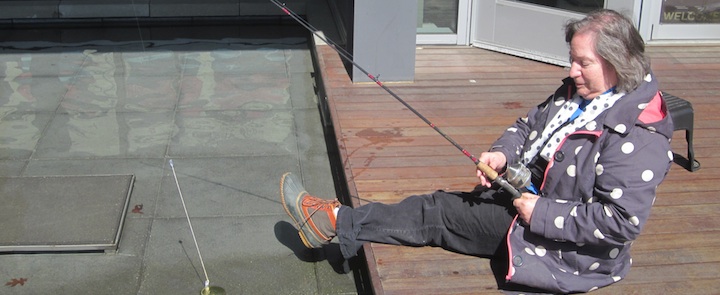By Joan Rudd, Special to The Jewish Sound
I just spent six weeks gallery-sitting in a Jewish cultural heritage exhibit, for the most part by myself, next to Bellevue’s city hall. I designed and created the exhibit over a three-year period in collaboration with a cohort of Baby Boomers, a professional photographer, graphic artist, and printer.
Nothing bad happened. There were zero unpleasant incidents. I was never scared.
Unlike the “Jew in a Box,” a radical exhibit at the Berlin Jewish Museum last year, I was not sitting in a Plexiglass box. I was there four afternoons a week, for a four-hour shift, giving tours and answering questions, starting with “Are you a Jew?”
Here is what this educational exhibit was trying to do: Cultivate understanding by de-mystifying a culture and defusing stereotypes.
Here is what I learned: The most surprising, frequent and incorrect remark referred to Jews as a “race.”
Even college-educated people were unaware of basic Jewish history including the “sack” of Jerusalem in 70 A.D., the expulsion from England in 1290, or the Spanish Inquisition in 1492. A map of the Pale of Settlement also had to be explained in the context of the Holocaust. “How could a people go through so much, and still endure!” said someone with a Jewish name, and childhood memories of a seder held at some friends’.
“Where is the cup for Elijah?” he also remembered, and wanted to know.
The vast majority of visitors were not Jewish, and there were a number of interfaith couples, not all of them young. Visitors who identified as one-quarter Jewish seemed to be the most interested in learning at least something about the Jewish part of their identity, or heritage, or health history. All said they “knew nothing.” Some came as family groups and taught each other as they toured. We had published three scheduled times to consult with someone from the Washington State Jewish Genealogical Society, and there was always a visitor present with questions for her on how to search.
I thought this was largely going to be an art exhibit, within a context of Jewish culture (Yiddish titles to the sculpture and “Voices and Visions” posters illustrating great ideas). Then, as we added more and more Jewish elements (a Passover table, set up with a box of matzoh and an extra chair for a guest, a hutch filled with holiday objects, a mock-up of a Torah mantle, stuffed with two bolsters), I thought we had a mini Jewish Museum. As the spring weather improved, and we had more people walking in, it became obvious that what we really had on our hands was a diversity exhibit. People on their way to City Hall, and those from City Hall on lunch break stopped in, as did passersby.
Located across from the Bellevue Transit Center, we were visible to brand new immigrants (Mexico, Ukraine) and less-recent immigrants (from the Philippines, India, England) coming through and asking basic questions. The exhibit windows facing the Transit Center had the Hebrew alphabet in both printed and cursive form, as well as a colorful mural of children. The sign read, “Pop-Up Cultural Heritage Exhibit: Setting a Place at the Table.” The timeline stated, “Jewish culture.”
I did not ask anyone if they were Jewish, though people asked me. Four Latino visitors, three African-American visitors, two Filipino visitors, two Indian visitors, two Ukrainian visitors, one English visitor, and one Japanese visitor stopped in. Intermarried family groups came in together. All ages came: Infant to late 80s. People in their 80s particularly appreciated this as a history exhibit, with its photographs of changes in everything from cooking equipment to media dating from the late 1940s until today.
One of the Indian visitors, after carefully studying the sculpture of family groups, none of it devotional, commented there was nothing particularly Jewish about this figurative sculpture. Aha! The unifying and universal theme: Some things change over time (like technology), some things do not (the family, the festivals, and the “table”). This holds true for many, many cultures. We get a great deal by appreciating the similarities between groups. We have at least had some similar experiences. And we are largely a nation of immigrants.
Photo: Courtesy Joan Rudd
Artist and gallery sitter Joan Rudd goes gefilte fishing during her popup Jewish museum exhibit.
